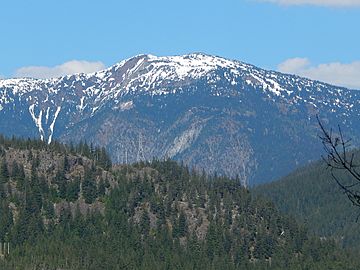Little Jack (Mountain) facts for kids
Quick facts for kids Little Jack |
|
|---|---|

Little Jack seen from the west on North Cascades Highway
|
|
| Highest point | |
| Elevation | 6,745 ft (2,056 m) |
| Prominence | 625 ft (191 m) |
| Geography | |
| Parent range | North Cascades |
| Topo map | USGS Crater Mountain |
| Climbing | |
| Easiest route | Hiking trail |
Little Jack is a mountain peak in the North Cascades mountain range. It stands 6,745 feet (about 2,056 meters) tall. You can find it in Washington, United States.
This mountain is part of the Pasayten Wilderness. It's located about one mile south of a bigger mountain called Jack Mountain. To its west is Ross Lake, and to its east is Crater Mountain. Little Jack is special because it rises very steeply from the land around it.
In the early 1900s, the Forest Service built the Little Jack Trail. This trail was used to help pack animals graze in the mountain's meadows. The name "Jack" comes from Jack Rowley. He was a gold prospector in the late 1800s who found gold at Ruby Creek.
Understanding Little Jack's Weather
Little Jack is in a "marine west coast" climate zone. This means it gets a lot of moisture from the Pacific Ocean. Most weather fronts (which bring weather changes) start over the Pacific. They then travel east towards the Cascade Range.
When these weather fronts hit the tall peaks of the Cascade Range, they are forced to rise. As the air goes up, it cools down and drops its moisture. This causes a lot of rain or snowfall on the mountains. This process is called Orographic lift.
Because of this, the western side of the North Cascades gets a lot of rain and snow. This is especially true during the winter months. Winters are often cloudy here. However, during summer, high-pressure systems over the Pacific Ocean bring clear skies.
The snow in this area tends to be wet and heavy. This can lead to a high risk of avalanches. Water from the mountain flows into the Skagit River.
How Little Jack Was Formed
The North Cascades mountains are known for their rugged look. They have sharp peaks, long ridges, and deep valleys carved by glaciers. The story of how these mountains formed began millions of years ago.
Around 50 million years ago, the North American Plate was slowly moving over the Pacific Plate. This movement caused many volcanic eruptions. Also, small pieces of the Earth's crust, called terranes, crashed into North America. These collisions helped create the North Cascades.
Little Jack Mountain is actually part of a specific terrane called the Little Jack terrane. You can find rocks like granite and mica schist on top of Little Jack Mountain.
Over two million years ago, during the Pleistocene period, huge sheets of ice called glaciers moved across the land. They carved out the landscape, leaving behind rock debris. The "U"-shaped valleys you see today were formed by these glaciers. The combination of land being pushed up (uplift) and cracks in the Earth's crust (faulting), along with glaciation, created the tall peaks and deep valleys of the North Cascades.
Images for kids
-
Jack Mountain, Little Jack, and Crater Mountain with Diablo Lake






